…they’re coming to get you, Barbara…
George Romero’s 1968 film, “The Night of the Living Dead” is a movie almost anyone with an interest in cinema is familiar with. It doesn’t matter if you’re a fan of horror or not, most everyone has at least heard of this groundbreaking low-budget film that first introduced the world to the zombie.
The idea that our loved ones could come back from the dead to kill us has been played over and over in countless sequels, remakes, rehashes, reboots, video games, television shows, comic books, etc, etc. Regardless of whether the “living dead” are called zombies, walkers, biters, or simply, the undead, one theme remains consistent between all of the various incarnations of the zombie subculture, which is, if you want to stop them for good, you gotta shoot em in the head.
Well sadly, sometimes the same thing can be said about cameras. If you’ve read any of my articles here before, you know that I put a great deal of emphasis of restoring cameras to a usable condition. I talk about this in great length in my article Breathing New Life into Old Cameras, and I talk about what to look for when buying used cameras in Mike’s Guide to Buying Old Cameras.
No matter how hard you try, some just won’t work. Old cameras are old, and very few were ever designed to last more than a few decades. No amount of lighter fluid, Q-tips, or internet tutorials will revive every old camera, and sometimes they must be put to rest. (Disclaimer: I’ll never destroy or throw away a dead camera, I’ll either display it, use it for spare parts, or if I think the camera’s rarity still gives it some value despite it’s condition, I will sell it on eBay with a full disclosure that it doesn’t work.)
So while I have the intent with every camera I buy to use it and hopefully get some good results to write about, sometimes that just doesn’t happen. I thought it might be fun to write a little about my “Cameras of the Dead”. The ones that for one reason or another, will never give me any images.
Kochmann Reflex-Korelle (1935)
This is a Reflex-Korelle single lens reflex camera made by Franz Kochmann, later Korelle-Werk, in Dresden, Germany. The Reflex-Korelle is one of the earliest examples of a single lens reflex camera. It took twelve 6cm x 6cm images on 120 format roll film. It had a cloth focal plane shutter and a 40.5 mm interchangeable lens mount. Later revisions of the Reflex-Korelle had shutter speeds as slow as 2 seconds and as fast as 1/1000, but this is an earlier model which could only do 1/25 – 1/500 seconds. The Reflex-Korelle was a relatively successful model being sold before and after WWII. Later revisions were sold as late as 1952.
Film Type: 120 roll film (twelve 6cm x 6cm exposures)
Lens: Ludwig-Dresden Victar 7.5cm f/3.5 uncoated
Focus: 4 ft to Infinity
Shutter: Cloth Focal Plane
Speeds: B, 1/25 – 1/500
Exposure Meter: None
Battery: None
Manual (in German): http://www.cameramanuals.org/pdf_files/korelle-reflex_model-i_ii.pdf
My Thoughts
The Reflex-Korelle is a pretty distinct looking single lens reflex camera made by Franz Kochmann in the mid 1930s. Kochmann’s earlier models were reflex box cameras that would use a moving mirror inside of a large box with a top down viewfinder.
Although pretty popular when first released, time has not been kind to these cameras. For one, they were on the cutting edge of camera design for the 1930s and employed experimental methods for moving the mirror involving a piano string, and the shutters were relatively rudimentary designs.
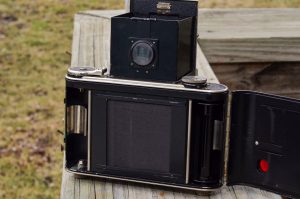
While not resembling what we could consider a modern SLR camera today, you can see the basic parts are there. There’s the waist level finder common of early SLRs like the Kine Exakta, there’s a cloth focal plane shutter behind a hinged film compartment door. Inside of the large cube in the middle of the camera is a large moving mirror that flips up when firing the shutter, and there’s even an interchangeable lens mount.
It is extremely difficult to find a Reflex Korelle in working condition, and even harder to find someone to repair them. There is an interesting post on photo.net by Cliff Manley who successfully restored a Reflex Korelle and in his own words:
Not only (is the Reflex-Korelle a) bad design, but (it’s) also built badly. I’m showing it here just because it was such a pain to get working. In fact when I say fix, it really is not the correct term for something that never worked correctly from the beginning.
I was well aware of the Reflex-Korelle’s reputation prior to acquiring this example, and I knew there was a very good chance it wouldn’t work. Luckily, the camera’s price was in a territory where I was willing to take a risk. After all, the body looked complete, the leather wasn’t peeling and even the shutter curtain looked to be in tact.
Upon receiving the camera, sadly I discovered that it wasn’t working. I had hoped that maybe if I could get one or two shutter speeds to work, I could shoot at only one speed, or if the curtains had holes in them, that I could use some fabric paint to get at least one test roll through it. But it wasn’t meant to be. Although the first shutter curtain was in pretty good shape, the second curtain was shredded. I could cock and fire the shutter, but the second curtain wouldn’t close at any speed. I could have used this camera as some sort of long exposure astrophotography camera and mounted it on a tripod in the night sky to take minute long exposures, but there was no way to use this shutter in anything resembling normal light.

The problems didn’t stop with the shutter, the reflex mirror was badly desilvered. a common problem with older cameras as humidity and other pollutants can cause the front side reflective material on the mirror to dissolve or chip away. Looking through the viewfinder was very dark. The image to the left is misleading as I boosted the levels in Photoshop to get something visible. In reality, the school bus was very hard to see.
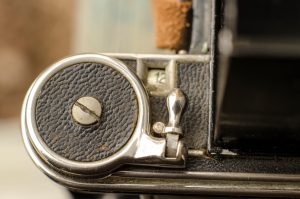
In person, the Reflex Korelle is quite a nice camera to look at. While I have a general goal with collecting cameras to only keep ones that work, I sometimes do make exceptions. I have always loved the nickel and leather look of 1930s German cameras, and this one displayed quite nice.
I really liked some of the small details of the camera. The frame counter was made out of something resembling ivory. Most likely it was a type of white Bakelite plastic, but it looked cool. The wind knob had this flip up handle that resembled a small bowling pin. This bowling pin was how you could both cock the shutter and reset the mirror.
I went back and forth on whether or not to keep this camera, but my decision was made as I had acquired this camera along with a lot of other cameras that cost me a bit of money and I wanted to recoup some of that money. I listed it on eBay with some nice photos of the camera, and an accurate description of the camera. When it sold, I was able to double my money on what I paid for it.
Reflecting on this camera now, I still like the design and wish I had kept it. I think that if I could get one of these in working condition, it would be a fun way to shoot 6×6 medium format. I’ll keep this camera on my radar for a future purchase if I ever find one in nice enough shape for a price that’s not too high.
KMZ Kristall (1962)
This is a KMZ Kristall (Кристалл in Cyrillic loosely translates to ‘crystal’) Single Lens Reflex camera made by Krasnogorski Mekhanicheskii Zavod in the former Soviet Union from 1961 – 62. It is an evolution of the Zenit 3 SLR and improved upon that model with a new hinged film compartment and a lever wind film advance. The Kristall has a unique hammered paint finish with prominent ribs above the prism which gave it a very distinct look. The look obviously didn’t appeal to customers as the camera was discontinued after little more than a year, and no other Zenit cameras that would follow would have a similar design. Despite it’s modest specs, this was a well built camera that used the Zenit’s 39mm lens mount and could share all lenses made for the entire Zenit SLR line.
Film Type: 135 (35mm)
Lens Mount: 39 mm screw Zenit mount
Lens: Industar-50 5cm f/3.5 coated 4-elements
Focus: 0.65 m to Infinity
Shutter: Cloth Focal Plane
Speeds: B, 1/30 – 1/500 seconds
Exposure Meter: none
Battery: none
Flash Mount: PC socket
Manual (in Russian): http://www.zenitcamera.com/mans/kristall/kristall.html
My Thoughts

I am no stranger to Soviet made cameras. I have gushed over the beautiful design of the Kiev 4, the perfectly balanced and clean looking Zorki 4, and the compact and ergonomic FED 2, but one that has eluded me for quite some time is the Zenit SLR.
I don’t necessarily think the Zenit is ugly, but its just not a model that has spoken to me to pick one up. One day, while browsing sovietcams.com I came across a variant of the Zenit called the Kristall. It had a look unique compared to just another Zenit SLR. It had a relatively modern design, with a hinged film compartment, pentaprism viewfinder, and lever wind film advance. Being an SLR, it had an interchangeable lens mount using the Zenit’s 39mm screw mount. It’s worth noting that although many rangefinders also use a 39mm lens mount, the pitch and flange focal distances are different on the Zenit’s screw mount. You cannot use 39mm Leica Thread mount (or compatible) lenses on this camera.
This camera certainly didn’t look like any other Zenit and really didn’t look like any other camera of the day. The hammered paint design of the top plate and prominent ribs above the pentaprism really makes the Kristall stick out. Perhaps it was this unique look that turned off buyers back then as the camera sold poorly and was available for less than 2 years and after its discontinuation, no other Soviet camera had a similar look. Despite it’s polarizing design, the camera really should have sold pretty well but I guess it wasn’t meant to be.
Typically when looking for an uncommon model, they either don’t show up for sale often, or they go for crazy prices, or both. Sometimes though, you get lucky, and I guess whatever day I bought this camera, was my lucky day as I got it for the princely sum of $10. From the auction pictures, I could see some of the body covering was peeling and the camera had the usual amount of dirt and grime, but these old Zenits were often built with cold-war era toughness. Soviet cameras of the early 1960s were meant to take a licking, which is why many of them are still in good operating shape today.
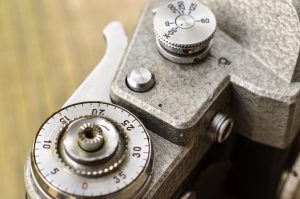 Sadly, that was not the case with this Kristall. The curtains were surprisingly OK, but the slow speeds were way off. As I recall, anything slower than 1/100 wouldn’t fire at all. That wouldn’t have been a deal breaker if there wasn’t also an issue with the mirror getting stuck every time you fired the shutter. I’ve encountered several other SLRs that had mirror issues, and usually the issue lies beneath the bottom plate, but that didn’t seem to be the case with this one. The whole camera was stiff, from the lens movements, to the film wind. I don’t have a lot of success opening SLRs, and this one seemed to have more issues than just general stiffness.
Sadly, that was not the case with this Kristall. The curtains were surprisingly OK, but the slow speeds were way off. As I recall, anything slower than 1/100 wouldn’t fire at all. That wouldn’t have been a deal breaker if there wasn’t also an issue with the mirror getting stuck every time you fired the shutter. I’ve encountered several other SLRs that had mirror issues, and usually the issue lies beneath the bottom plate, but that didn’t seem to be the case with this one. The whole camera was stiff, from the lens movements, to the film wind. I don’t have a lot of success opening SLRs, and this one seemed to have more issues than just general stiffness.
I don’t even know if I had been able to resolve all of the mechanical problems with the camera, that I would have enjoyed shooting with it. The viewfinder was dim, and the ground glass was simply a flat piece of matte glass. There were absolutely no focus aides, no pentaprism collar, no split image rangefinder, nothing. As I have stated in other reviews, my vision is pretty bad, and I often struggle with dim SLR viewfinders, and this one was the dimmest I had ever seen.
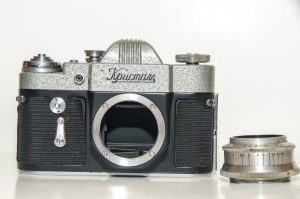
So, while I think this was a nice looking camera, it had too many conditional issues, plus a viewfinder that would have been extremely difficult for me to use, so off to eBay it went. I had this camera for such a short period of time, I never bothered to take some “glamour” shots of it like I usually do. These images here with the white background were from the eBay listing when I sold it. I honestly can’t remember what I got for it, it probably wasn’t a lot, but I know I made back my money on it.
I definitely see another Zenit in my future. I’ll probably go for a later model to maximize my chances at a brighter and easier to use viewfinder, but for now, the Kristall will remain a brief memory in my collection.
Kodak Signet 80 (1958)
This is a Kodak Signet 80 rangefinder camera made by the Eastman Kodak company out of Rochester, NY in 1958. It was the most advanced, and also the last of the Signet line of cameras. It was the only Signet model to have an interchangeable lens mount and represented one last attempt by Kodak to make a mainstream “system” camera. A combination of high prices and low specs doomed the camera from the beginning and it did not sell well. The Signet 80 was one of Kodak’s last attempts at building anything resembling an advanced camera as all new models released after this camera were cheap point and shoot Instamatic models. Despite it’s lackluster history, this is a solidly built camera with a couple of compelling features, and like most of the Signet line, came equipped with very capable lenses.
Film Type: 135 (35mm)
Lens Mount: Scissors Lock Signet 80 Mount
Lenses: Kodak Ektanar 50mm f/2.8 and Signet Wide Angle 35mm f/3.5 coated 4 elements
Focus: 2.5 feet to Infinity
Type: Coupled Rangefinder
Shutter: Leaf
Speeds: B, 1/4 – 1/250 seconds
Exposure Meter: Selennium Cell
Battery: none
Flash Mount: Cold Shoe, PC M & X Socket, Kodak proprietary flash mount
Manual: http://www.cameramanuals.org/kodak_pdf/kodak_signet_80.pdf
My Thoughts
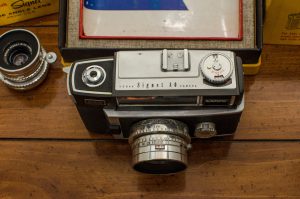
There was once a time when I fell victim to the popular theory that the only good Kodak cameras were ones with the name “Retina” on them. Then I discovered the Kodak Medalist. A honking beast of a solid piece of metal with one of the most amazing 5 element Ektar lenses on it. Next came a little afterthought of a camera that I paid $5 for, called the Kodak 35 with the Anastigmat Special lens. This little 1930s Bakelite gem has turned out to be one of my favorite vintage cameras of the 80+ in my collection. After that came the mostly aluminum Kodak Signet 35. It was the first in a whole series of Signet cameras, and was an extremely handsome camera in a mostly aluminum body with an awesome 4 element Ektar lens.
I was getting cocky. Upon learning of a more advanced Signet model that had interchangeable lenses, and a similarly good Ektanar lens, I knew I had to have one. Ironically, the one pictured here is the second one I tried to buy. The first was one I won on eBay and paid for, but the seller never shipped it. A claim to eBay and 30 days later, I got my money back, no worse for the wear, so I set my sights on another. My fortunes turned good as I found a very clean looking example in its original box, with a nice field case, and the Signet wide angle auxiliary lens. Score! Two lenses for the price of one!
My excitement turned to dismay as I received the camera as it was in pretty terrible shape. For one, the auxiliary lens was completely seized and I could see one of the iris blades was dislodged. The 50mm lens was OK, but very stiff. The viewfinder was large and bright, but the rangefinder had severe vertical alignment problems. Usually a small amount of vertical error won’t negatively affect your focus, but this was way off. Finally, the deal breaker was that I could cock the shutter, but nada. It was seized.

Thinking I had another job for my trusty bottle of Ronsonol lighter fluid, I soaked this thing, repeatedly, but no amount of lubrication would get the shutter to budge. I came to the conclusion that something was physically damaged inside of the camera. The first time I removed the lens, I could see a metal plate that encircles the shutter was loosely flopping around inside of the body. I thought perhaps I could open the body, but the solid Bakelite plastic did not reveal how to get itself open. I searched online for CLA instructions on this camera and found none.
The Signet 80 did not sell well. While it should have been a pretty desirable model for Kodak, the very limited selection of shutter speeds, coupled with it’s ‘love it or hate it’ styling, and it’s $130 price tag in 1958 (when adjusted for inflation, thats $1082 today) meant that very few were sold. I found stories that around the time of it’s discontinuation, camera shops had these things on clearance on the shelf trying to sell them at bargain prices and still had a hard time moving them.
So, with so few sold, and it’s rather poor reputation, its no surprise that finding repair information on them today is difficult. I quickly realized that I was over my head, and knowing that I had at least a cosmetically good looking specimen with it’s original box, field case, and an extra lens, I listed it on eBay and broke even.
Would I take a chance on another Signet 80? I honestly don’t know. I can say that if you like quirky cameras, this one has quite a few for you. For starters, the shutter speed selector is on a dial on the front of the camera, kinda like an Argus C3. I can forgive this odd location on the Argus considering that camera was designed in 1938. This one came out 2 decades later and Kodak should have known better. Second, the frame counter was strangely on the bottom plate of the camera, just beneath the lens. It’s a very strange location and one that’s not even obvious the first time you look at it. I would not be surprised if at least a few people used this camera without ever realizing there is a frame counter on it.
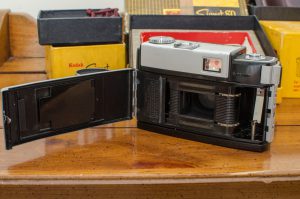
Finally, the strangest design element of the camera is something Kodak actually advertised as a good thing. The film compartment had no takeup spool. Instead it had a hollow chamber that allowed the exposed film to coil around itself in as you advanced the film. Kodak referred to this as “injection” loading. The idea was that by not needing a takeup spool, the loading process was greatly simplified. You would simply install a new cassette on the supply side, and then feed the film leader into a slit that opened into the hollow chamber, and then close the door. As you advanced the film, two gears would pull the film out of the cassette and feed it into that slit upon where the film would just form a coil around itself.
It probably worked better than it sounds, but still, I can’t think of any other camera or manufacturer who tried this feature, so clearly it was not received well by the public.
Sadly, the Signet 80 could have been a much better camera. The viewfinder was large and bright. The Bakelite body, while lightweight, was sturdy and rugged, and the lenses available for the Signet were quite good. Take a look at this post on photo.net by Louis Meluso who writes about his Signet 80 and shows some excellent sample shots taken with his.
I will never understand Kodak’s insistence in the mid 20th century to make cameras with excellent optics, and pair them with low-spec shutters and oddball designs.
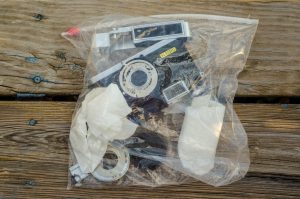
My Conclusions
If you are new to this hobby, it doesn’t take long to remember that vintage cameras don’t always work like they used to. While many ailments that old cameras typically suffer from can be easily remedied with some cleaning, sometimes it really requires a specialized repair person. Back in the day, it might have been worth it to pay a specialist to repair some of these models, but not anymore. Many of these cameras are worth so little, that unless you had some special sentimental attachment to a particular model, you’d be crazy to pay to get these things repaired.
While I have been very fortunate to get quite a few cameras in good working order, it’s not always so. If you are a frequent reader to my site, you might think that vintage cameras rain from the sky and I continually shoot with everything I get. While I’ll admit, my success to failure ratio is pretty good, I do have some disappointments, but that doesn’t mean that I can’t still find something to say about those models.
Each of the three models featured here are all very interesting models in their own ways. I was very sad to not be able to shoot with each of these, especially the Reflex-Korelle. Each of these would make fine display pieces, but my funds are quite limited. There is a reason that there isn’t a single Leica or Rollei product reviewed on this site as I cannot afford them. So, when I get a camera that doesn’t work, I have to think, do I like it enough to eat the cost and just display it, or is there a way I can salvage my money to try again on something else? Almost always, ‘try again on something else’ wins.
So, there you have it. The reviews on this site are not all successes. These aren’t the only 3 I could write about. Maybe I’ll make a “Cameras of the Dead” Part Deux soon with some more failures!

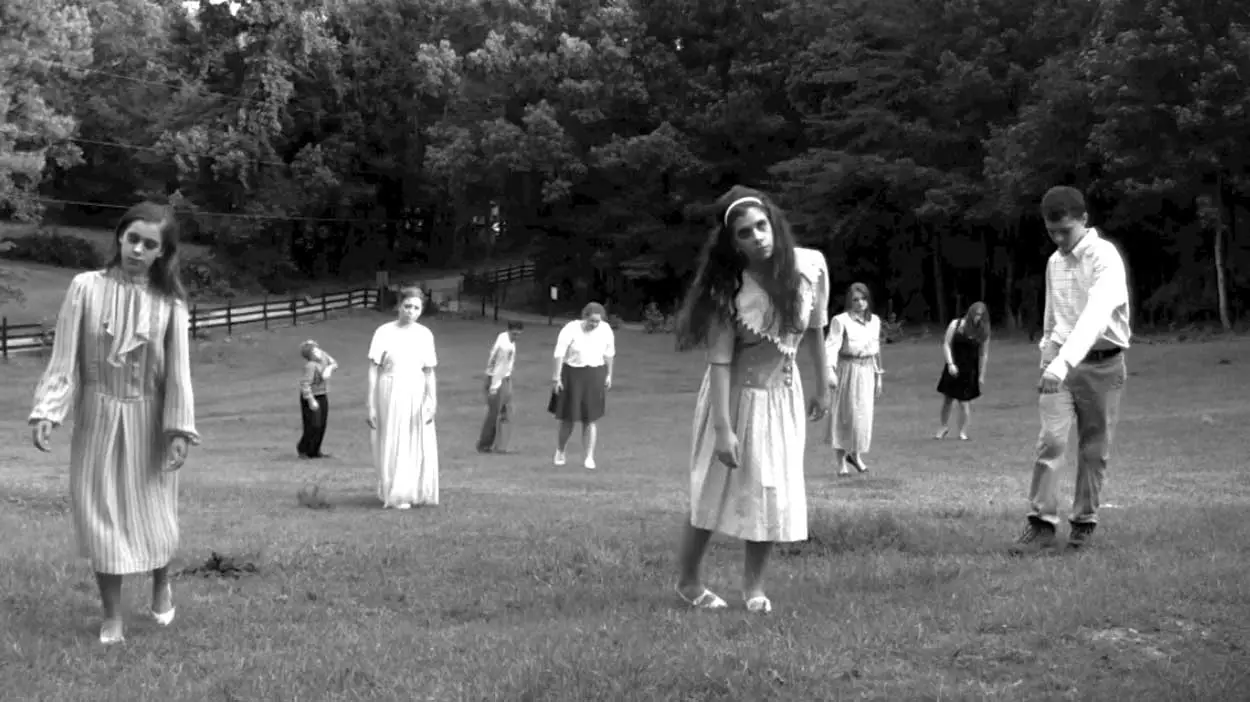
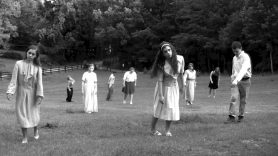
![night-[1]](https://mikeeckman.com/wp-content/uploads/2016/08/night-1-1024x575.jpg)
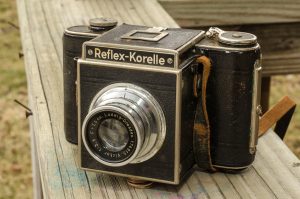
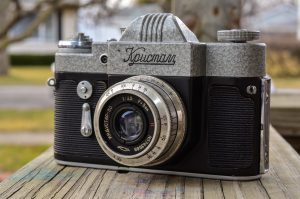
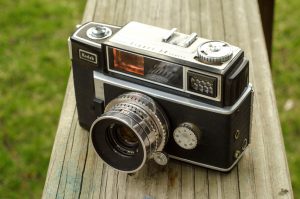
I have this model as well and mine worked through approximately one roll of film. There is some type of problem with the film transport system. When I put the film in and operate the film advance lever several times, the exposure counter comes up to “1” as it should, but after a few pictures, there is increased tension on the film advance lever and I can no longer operate it or the shutter release The film appears to get stuck mid roll so the camera has been relegated to my display case for a while now. It’s a shame because the lens was really sharp and it took fantastic pictures while it worked!